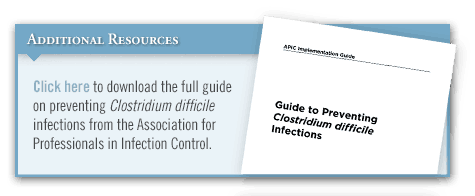According to the CDC, the mortality rate associated with Clostridium difficile infection (CDI) increased by 400% between 2000 and 2007, due in part to a stronger germ strain. CDI accounts for approximately 14,000 deaths each year in the United States. Current estimates show that the average total cost for a single inpatient CDI is more than $35,000, and the estimated annual cost burden for the healthcare system exceeds $3 billion.
“Preventing the transmission of CDI continues to be a serious and difficult challenge in hospitals throughout the U.S.,” says Ruth M. Carrico, PhD, RN, FSHEA, CIC. “The epidemiology of CDI is changing [Figure]. Its presence in hospitals and other health-care settings has caused medical personnel across the entire continuum of care to reevaluate approaches and perspectives to preventing and managing this potentially lethal infection.”
A National Action Plan on CDI Prevention
The U.S. Department of Health and Human Services released the National Action Plan to Prevent Healthcare-Associated Infections: Roadmap to Elimination in 2009. The document, available at www.hhs.gov, provides a roadmap for preventing healthcare-associated infections (HAIs) in acute care hospitals, ambulatory surgical centers, long-term care facilities, and other healthcare settings. CDIs were among the first HAIs specifically targeted in the action plan because rates have been increasing in recent years. The Association for Professionals in Infection Control and Epidemiology (APIC) has
been involved in promoting and supporting the elements included in this national plan through development of specific guidance aimed at the healthcare practice level.
In 2013, APIC issued an updated implementation guide to help clinicians further protect patients from CDI. The update contains new material and revised content on evolving practices and new discoveries. The guide includes information on the changing epidemiology of CDI, strategies for prevention, considerations for specific patient populations, and new and emerging technologies. It also features practical tools, checklists, frequently asked questions, and a glossary of terms. Topics include (among others):
“The updated guide from APIC provides practical, evidence-based strategies for surveillance and elimination of CDI,” says Dr. Carrico, who was lead author of the guide. “Its purpose is to provide practical, ‘how-to’ information and online tools and resources that encompass the latest research and regulatory requirements.” She notes that open access ensures that this information is available to the widest possible audience.
Prevention Strategies for Clostridium Difficile Infection
Key prevention strategies for CDI are outlined in the APIC implementation guide. They focus primarily on judicious antimicrobial use, environmental cleaning, and preventing transmission using basic infection prevention and isolation precautions (Table). Early
identification of suspected or diagnosed CDI is a first step to preventing spread of the disease. Adherence to recommendations for contact precautions, hand hygiene, and antimicrobial stewardship can help to break the chain of CDI transmission throughout hos-pitals and other healthcare facilities.
“The updated guide from APIC provides practical, evidence-based strategies for surveillance and elimination of CDI.”
“Knowing the incidence of CDI in your setting, understanding barriers to compliance with hand hygiene standards, and ensuring environmental cleanliness will help your team select the most appropriate interventions to prevent transmission of these infections,” says Dr. Carrico. “Infection prevention experts, liaisons, and staff should be consulted so that their assistance can be utilized when monitoring adherence to preventive practices. Antimicrobial stewardship programs should be implemented to monitor and evaluate antimicrobial use.”
Education Warranted for Physicians & Patients
Patient and healthcare personnel education is important component to preventing CDI, according to the APIC update. “Information about C. difficile and its transmission must be shared with patients and their families,” Dr. Carrico says. “Clinicians need to take time to instruct patients on hand and personal hygiene. They should also be informed about the importance of environmental cleanliness and how this illness may impact them and others once they go home.”
For clinicians, ongoing education on the modes of infection transmission, rates of CDI, and infection prevention interventions is needed. These rates and interventions should be communicated to senior leadership and administrators along with information about adherence monitoring. “It’s important to provide concrete examples of ways to support infection prevention rather than using vague concepts,” adds Dr. Carrico.
Considering the increasing incidence of CDI in both healthcare facilities and the community, Dr. Carrico says clinicians need to pay more attention to teaming with patients, long-term care residents, and families when making care management decisions. In addition, critical partners in the battle with CDI include environmental services personnel. “As the collaboration between environmental services professionals and infection preventionists continues, it’s hoped that more innovative strategies will emerge,” she says. “Partnering with patients and healthcare facility personnel has the potential to help us reduce the burden of this challenging pathogen.”




 admin
admin